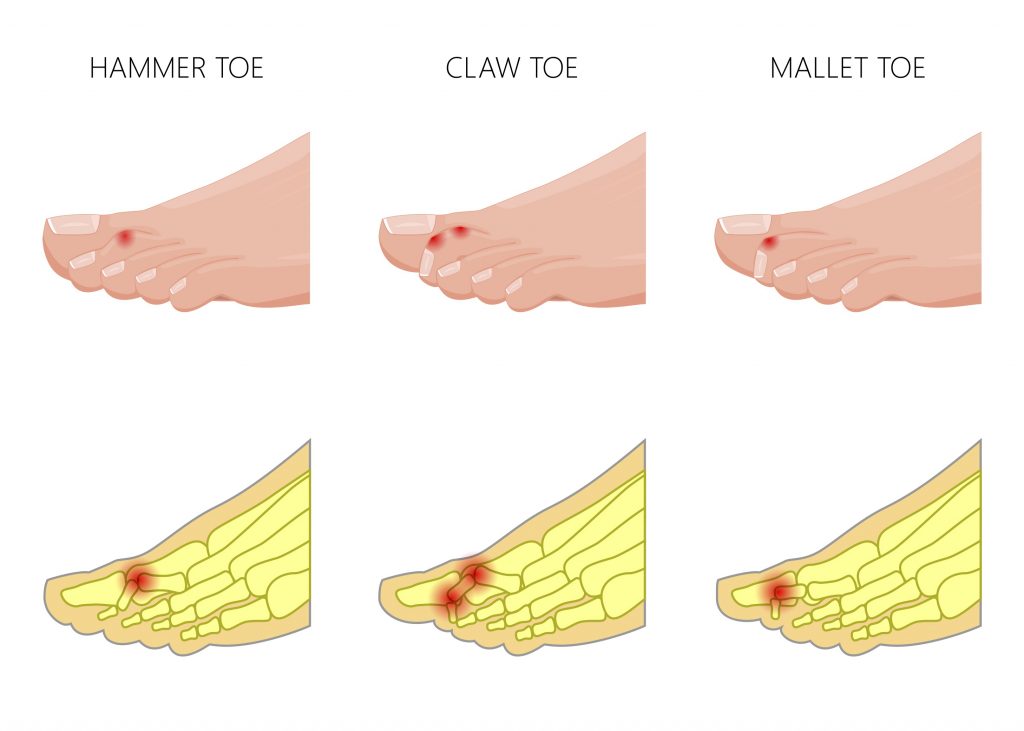Hammertoes
If the ends of your toes resemble more of a hammer than they do straight toes, then it sounds like you may have developed a hammertoe deformity. Hammertoes curl through at the middle of the toe before straightening again at the tip. This is similar to claw toes, with the difference being the tips of claw toes keep pointing down towards the ground, and mallet toes, where the toe remains straight until the tip which points downwards.
Here is a great illustration of these differences from Advanced Foot & Ankle.

What causes a hammertoe?
 As you can see in the illustration above, each of your toes has two joints between three bones – aside from the big toe which only has one joint between two bones. Hammertoes develop when abnormal forces or pressure on the toes or force the joints into a bent position for prolonged periods, leading to permanent changes to the joints and the muscles and ligaments surrounding the joints. The muscle or tendon imbalances may also be caused by neurological factors, like nerve damage and certain medical problems including arthritis.
As you can see in the illustration above, each of your toes has two joints between three bones – aside from the big toe which only has one joint between two bones. Hammertoes develop when abnormal forces or pressure on the toes or force the joints into a bent position for prolonged periods, leading to permanent changes to the joints and the muscles and ligaments surrounding the joints. The muscle or tendon imbalances may also be caused by neurological factors, like nerve damage and certain medical problems including arthritis.
The most common causes for pressure on the toes are tight, narrow or poorly fitting footwear that cramps the toes and forces them back into a hammer-like position. Having a long second or third toe is also a common factor, as most people measure their shoes to their big toe without thinking that their second or third toes could be longer and need more space.
Your genetics may also predispose you to hammertoes. Other contributing factors include previous injuries and pressure from a bunion or other foot deformity.
Signs & symptoms
Aside from the obvious change in the shape of the toes, your toes may become red, swollen, stiff and painful. Many people also develop corns, calluses or blisters on the tops where the joints rub against the shoes. This can make it uncomfortable and painful to walk or wear certain types of shoes.
Treating hammertoes
 When the changes to the joints are caught early, it’s the easiest to get the best results using conservative (non-invasive or surgical) treatments. The longer the toes are left untreated, and the more rigid they are, the more difficult they can be to treat. Your care with us may include:
When the changes to the joints are caught early, it’s the easiest to get the best results using conservative (non-invasive or surgical) treatments. The longer the toes are left untreated, and the more rigid they are, the more difficult they can be to treat. Your care with us may include:
- Changes to your regular footwear to ensure it’s not making the problem progress at a fast rate
- Using strapping and splinting to help keep the toes in a better position and encourage them to straighten
- Manual therapy on the tendons and muscles themselves to help them loosen, including stretching and strengthening of the toes
- Custom foot orthotics or forefoot padding to support the healthy function and position of your feet
While we always try to correct your problem with conservative measures first, in advanced cases, this may not be possible. If your hammertoes are causing you pain and making it difficult for you to walk or wear footwear, you may be referred to an orthopaedic surgeon to correct the problem surgically. It’s important to consider the risks of any surgical procedure and ensure that the benefits outweigh the risks.
FAQs
Can hammertoes be prevented?
While it may not be possible to prevent all cases of hammertoes, there are steps you can take to reduce the risk. These include:
- Choosing comfortable footwear with a wide toe box that allows your toes to move freely.
- Avoiding high heels or shoes with narrow, pointed toes that can squeeze the toes together.
- Wearing shoes that provide adequate arch support.
- Doing foot exercises and stretches to improve foot strength and flexibility.
When is surgery recommended for hammertoes?
Surgery for hammertoes is typically considered when non-surgical treatments have been ineffective, and the deformity causes severe pain, difficulty in walking, or interferes with daily activities. Other factors that may warrant surgical intervention include open sores or ulcers, toe stiffness, or if the condition is progressively worsening.
What is the recovery process after hammertoe surgery?
The recovery process after hammertoe surgery can vary depending on the extent of the procedure performed. Generally, you can expect some swelling, bruising, and discomfort in the affected area. Your podiatrist can offer great support throughout your recovery to help optimise your outcomes. Full recovery typically takes several weeks to a few months.
Will hammertoes come back after treatment?
Hammertoes can recur after treatment, especially if the underlying causes are not addressed or if preventive measures are not followed. To minimise the chances of recurrence, it’s important to address any biomechanical issues, wear appropriate footwear, use orthotics if recommended, and perform regular foot exercises to maintain foot strength and flexibility.
Can I wear regular shoes with hammertoes?
In many cases, wearing regular shoes can exacerbate the discomfort caused by hammertoes. It’s generally recommended to choose footwear that accommodates the deformity and provides enough space for the toes to move freely. Look for shoes with a wide toe box, soft upper materials, and good arch support. Avoid high heels, narrow or pointed toe boxes, and shoes that squeeze or put excessive pressure on the affected toes.
Are there any exercises or stretches that can help with hammertoes?
There are exercises and stretches that may help improve the flexibility and strength of the toes, which can provide some relief for hammertoes. These exercises may include toe stretches, towel curls, marble pickups, and toe scrunches. It’s always important to consult with a podiatrist for the best guidance on the specific exercises that are appropriate for your circumstances.
Can wearing high heels or narrow shoes contribute to hammertoes?
Yes, wearing high heels or shoes with narrow toe boxes can contribute to the development of hammertoes. These types of shoes often force the toes into a bent position and put excessive pressure on the front of the foot, leading to the formation of hammertoes over time. It’s advisable to choose shoes with a lower heel height, a wide toe box, and adequate arch support to help prevent the development or progression of hammertoes.
How long does it take to heal a hammertoe?
The healing time for a hammertoe depends on the severity of the deformity and the treatment provided. Often it may take several weeks to months for noticeable improvement. For surgical procedures, these typically involve a recovery period of a few weeks to several months, during which the foot gradually heals, and you regain full mobility and functionality.
Are there any long-term effects of hammertoes if left untreated?
If left untreated, hammertoes can lead to various long-term effects and complications. These may include chronic pain, difficulty in walking or wearing shoes, calluses or corns due to friction and pressure, toe deformities becoming more pronounced, the development of open sores or ulcers, and an increased risk of infections. It’s important to seek treatment to prevent these potential complications.
Can hammertoes lead to other foot problems?
Yes, hammertoes can contribute to the development of other foot problems. The imbalance caused by the toe deformity can affect the alignment of other toes and the overall mechanics of the foot. This can lead to issues such as corns, calluses, bunions, metatarsalgia (forefoot pain), and even problems higher up the leg, such as knee, hip, or lower back pain. Early treatment of hammertoes is important to prevent these secondary complications.


